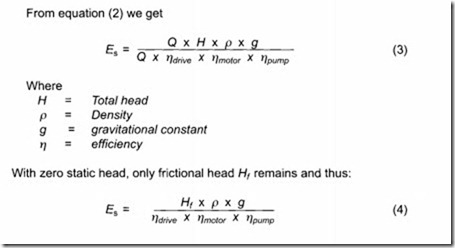Systems without static head or closed loop systems
The specific energy here is dependent on the frictional head loss which, in turn, is determined by the losses in the pipe system (including throttling valves), and by the combined drive-motor-pump efficiency.
The combined drive-motor-pump efficiency has to be evaluated for each duty point. It is to be noted that the pump efficiency remains approxi mately the same in a system of this type when the speed is changed, whereas the drive-motor efficiency can drop drastically as the load is reduced. If on the other hand, the system curve is changed by changing the setting of a valve, this will change the duty point of the pump and, hence, its efficiency.
Related posts:
Pumps:Reciprocating pump types
Applied Pneumatics:Flow analysis for cylinders and valves
Applications on pneumatic:Air bubble techniques
Applications on pneumatic:Industrial tools
Erosive wear:Wear of straight pipeline
Troubleshooting and material flow problems:Pipeline blockage and On commissioning.
Conveying characteristics:Energy considerations and The influence of conveying air velocity.
Hydraulic accessories:Hydraulic accessories.
Hydraulic pumps:Principle of operation.
Cartridge logic valves.
Servo valves.
Hydraulic and Pneumatic Accessories:Hydraulic Piping, Hosing and connections.
INTRODUCTION TO THERMAL-FLUID SCIENCES
PROPERTIES OF PURE SUBSTANCES:COMPRESSIBILITY FACTOR—A MEASURE OF DEVIATION FROM IDEAL-GAS...
SUMMARY OF PROPERTIES OF PURE SUBSTANCES
